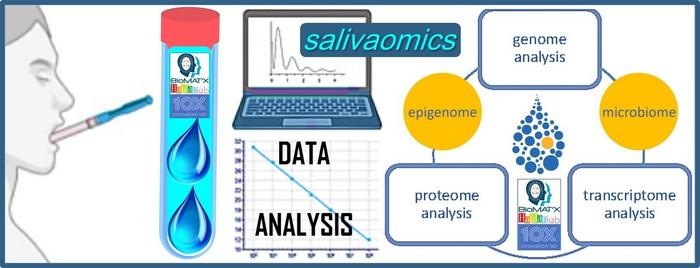Study Explores Impact of POC Testing on Future of Diagnostics
|
By HospiMedica International staff writers Posted on 10 Feb 2025 |

In today’s rapidly changing world, having quick and accurate access to medical information is more crucial than ever. Point-of-Care Diagnostics (PoC-D) and Point-of-Care Testing (PoC-T) are making this possible by bringing medical tests directly to patients, regardless of their location. Whether it’s in a clinic, at home, or in remote areas, these cutting-edge technologies are revolutionizing healthcare. A study delves into the new era of healthcare diagnostics, fueled by significant advancements in point-of-care (PoC) testing, artificial intelligence (AI), and research and development (R&D). These innovations are transforming how diseases are diagnosed and treated, especially in dentistry, medicine, and surgery.
The study, published in Biofunctional Materials, was led by Prof. Dr. Haidar, the Founder and CEO of BioMAT’X I+D+I LABs (Santiago, Chile), and examines the growing shift toward PoC-T. While PoC-D and PoC-T are often used together, they refer to distinct aspects of healthcare. PoC-D focuses on the systems and technologies that enable disease detection near the patient, while PoC-T pertains to the actual tests performed to quickly obtain results outside the traditional laboratory setting. Together, these technologies empower healthcare professionals—and in some cases, patients themselves—to make quicker decisions, leading to improved care and outcomes. PoC-D is becoming an essential part of clinical practice. By enabling on-site, real-time testing, these innovations are paving the way for faster, more accurate, and more accessible diagnostic solutions. One key area of focus is the development of PoC devices for use in dental practices, where rapid detection of systemic and oral diseases is crucial for effective treatment planning. By minimizing the need for patients to visit laboratories or specialized testing centers, PoC technologies allow healthcare providers to make timely decisions and improve outcomes.
The impact of innovations in PoC technologies on healthcare is significant. Examples include lab-on-a-chip devices, which perform complex tests using small samples, microfluidics and nano-biosensors capable of detecting disease biomarkers with remarkable precision, and AI technologies that enhance diagnostics by predicting diseases, analyzing data in real-time, and personalizing treatments. These advancements are unlocking the potential for faster, more reliable, and more accurate diagnoses. Ongoing research is working to integrate AI with PoC platforms to discover new, disease-specific biomarkers that could transform our approach to diagnosing and treating diseases, the study reports. This could lead to improved detection, monitoring, and even prediction of disease outcomes in fields such as dentistry, oral health, and general medicine.
The COVID-19 pandemic underscored the importance of quick, reliable diagnostics in controlling and preventing the spread of infectious diseases. PoC testing technologies, like rapid antigen tests and saliva-based kits, played a pivotal role in tracking outbreaks and providing immediate results to patients. These tests allowed for timely interventions, reducing transmission risks and improving treatment outcomes. The pandemic highlighted the need for more accessible diagnostic tools in all healthcare sectors. As a result, the demand for technologies that offer rapid results without compromising accuracy has risen sharply. The study anticipates that PoC testing will not only be crucial for infectious disease management but will also play a key role in chronic disease monitoring, routine screenings, and preventive healthcare.
Historically, testing required blood samples, but PoC technologies are now enabling disease detection through non-invasive methods, such as saliva. Saliva-based tests are particularly promising because they are easy to collect, safe, and have the potential to detect a wide range of conditions—from cancer to heart disease—without the need for complex procedures. One of the most exciting areas of research is the study of lantibiotics—small but powerful antimicrobial peptides produced by bacteria in the mouth. These peptides help fight harmful bacteria and may even play a role in preventing oral disease. Due to their potential to improve both oral and overall health, lantibiotics are a hot topic in research and development and innovation (R&D&I), with potential future applications in diagnostics. With the rise of “omics” technologies, such as genomics and proteomics, PoC diagnostics are becoming even more personalized. By identifying unique biomarkers in the body, these technologies enable healthcare providers to make more accurate diagnoses and develop personalized treatment plans. For example, proteomics (the study of proteins) shows promise in detecting diseases like oral cancer and even systemic diseases such as diabetes from saliva samples. While PoC technologies show great potential, the study also identifies challenges that need to be addressed, including technical issues, integration into healthcare systems, and data handling.
The future of diagnostics lies at the intersection of AI, data science, and advanced biomarker discovery. As AI-driven platforms are integrated into diagnostic tools, they are becoming more intelligent, precise, and efficient. These technologies can analyze vast amounts of data, including genetic and molecular profiles, leading to the identification of new disease-specific biomarkers. The study predicts a significant leap in PoC-D and PoC-T (point-of-care therapeutics) in the coming years, with AI enabling real-time monitoring, personalized treatment recommendations, and predictive analytics for disease progression. AI technologies are not only transforming diagnostics but also shaping treatment strategies, making them more targeted and patient-centric.
Looking ahead to 2025 and beyond, a key development to monitor is the super AI project (Stargate) recently announced by the U.S. administration. This initiative aims to usher in a new era of AI-driven healthcare solutions, potentially accelerating diagnostic capabilities across multiple sectors. The Stargate project is focused on advancing AI research, leading to breakthroughs that could further integrate AI into real-time diagnostics and personalized medicine, improving the accuracy and efficiency of healthcare globally. The study expects these innovations to enable healthcare professionals to make more informed decisions, improving the management of various conditions, from oral health to systemic diseases. The potential integration of AI into diagnostic platforms promises to provide patients with faster, more accurate, and comprehensive care while reducing costs and enhancing overall healthcare delivery.
The study concludes that ongoing R&D&I, particularly in AI integration, will continue to drive the development of PoC platforms. These advancements will not only accelerate the discovery of new disease biomarkers but also lead to more reliable and sensitive diagnostics that can be used at the point of care. Researchers are already exploring how AI can be used to improve biomarker identification, allowing for faster and more accurate detection of diseases, from oral conditions to systemic health issues. As healthcare systems worldwide continue to evolve, the study predicts these technological advancements will not only make diagnostics faster and more accurate but will also transform healthcare delivery globally. From chair-side dentistry to the broader healthcare ecosystem, the integration of PoC diagnostics, advanced AI systems, and real-time data analytics is expected to revolutionize clinical practices, offering a future of personalized, proactive, and precise care.
In conclusion, the study asserts that the convergence of PoC testing, AI, and advanced biomarker research will define the next generation of healthcare diagnostics. These technologies promise a future where medical professionals can detect, monitor, and treat conditions with unprecedented speed and accuracy. Looking ahead, the study expects PoC platforms to evolve into more reliable, sensitive, and comprehensive tools, pushing the boundaries of what is possible in diagnostics. Moving into 2025 and beyond, these innovations offer a glimpse into a future where healthcare is more accessible, efficient, and personalized—ultimately leading to better outcomes for patients worldwide.
Related Links:
BioMAT’X I+D+I LABs
Channels
Critical Care
view channel
AI-Powered, Internet-Connected Medical Devices to Revolutionize Healthcare, Finds Study
A new study suggests that artificial intelligence (AI)-powered, internet-connected medical devices have the potential to transform healthcare by enabling earlier detection of diseases, real-time patient... Read more
Starfish-Inspired Wearable Tech Enables Smarter Heart Monitoring
Physical movement can make it challenging for current wearable devices to accurately track heart activity. Now, a starfish’s five-arm shape has helped resolve this issue. Inspired by the starfish's ability... Read moreSurgical Techniques
view channel
New Transcatheter Valve Found Safe and Effective for Treating Aortic Regurgitation
Aortic regurgitation is a condition in which the aortic valve does not close properly, allowing blood to flow backward into the left ventricle. This results in decreased blood flow from the heart to the... Read more
Minimally Invasive Valve Repair Reduces Hospitalizations in Severe Tricuspid Regurgitation Patients
The tricuspid valve is one of the four heart valves, responsible for regulating blood flow from the right atrium (the heart's upper-right chamber) to the right ventricle (the lower-right chamber).... Read morePatient Care
view channel
Portable Biosensor Platform to Reduce Hospital-Acquired Infections
Approximately 4 million patients in the European Union acquire healthcare-associated infections (HAIs) or nosocomial infections each year, with around 37,000 deaths directly resulting from these infections,... Read moreFirst-Of-Its-Kind Portable Germicidal Light Technology Disinfects High-Touch Clinical Surfaces in Seconds
Reducing healthcare-acquired infections (HAIs) remains a pressing issue within global healthcare systems. In the United States alone, 1.7 million patients contract HAIs annually, leading to approximately... Read more
Surgical Capacity Optimization Solution Helps Hospitals Boost OR Utilization
An innovative solution has the capability to transform surgical capacity utilization by targeting the root cause of surgical block time inefficiencies. Fujitsu Limited’s (Tokyo, Japan) Surgical Capacity... Read more
Game-Changing Innovation in Surgical Instrument Sterilization Significantly Improves OR Throughput
A groundbreaking innovation enables hospitals to significantly improve instrument processing time and throughput in operating rooms (ORs) and sterile processing departments. Turbett Surgical, Inc.... Read moreHealth IT
view channel
Printable Molecule-Selective Nanoparticles Enable Mass Production of Wearable Biosensors
The future of medicine is likely to focus on the personalization of healthcare—understanding exactly what an individual requires and delivering the appropriate combination of nutrients, metabolites, and... Read more
Smartwatches Could Detect Congestive Heart Failure
Diagnosing congestive heart failure (CHF) typically requires expensive and time-consuming imaging techniques like echocardiography, also known as cardiac ultrasound. Previously, detecting CHF by analyzing... Read morePoint of Care
view channel
Handheld, Sound-Based Diagnostic System Delivers Bedside Blood Test Results in An Hour
Patients who go to a doctor for a blood test often have to contend with a needle and syringe, followed by a long wait—sometimes hours or even days—for lab results. Scientists have been working hard to... Read more
Smartphone-Enabled, Paper-Based Quantitative Diagnostic Platform Transforms POC Testing
Point-of-care diagnostics are crucial for public health, offering rapid, on-site testing that enables prompt diagnosis and treatment. This is especially valuable in remote or underserved regions where... Read moreBusiness
view channel
Expanded Collaboration to Transform OR Technology Through AI and Automation
The expansion of an existing collaboration between three leading companies aims to develop artificial intelligence (AI)-driven solutions for smart operating rooms with sophisticated monitoring and automation.... Read more




















